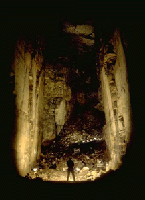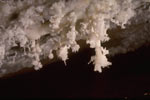Caving Areas In Great Britain
There are five main and a few minor caving areas in Britain, offering a wide variety of caving. These are:
Mendip

Copyright © S. Cottle
Local geology has produced a typical Mendip cave, with a steeply descending entrance, often levelling out at depth and ending in a sump. Few Mendip caves exceed 500ft in depth or a mile or two in length, but what they lack in quantity, they make up for in quality or variety with noisy streamways, fine grottos, squeezes and large chambers, often all in the same cave.
Information about access on Mendip
The Yorkshire Dales
Without a doubt, the Dales contain some of the country's finest and most spectacular caves. Most of the caves are situated around the "Three Peaks" area (Ingleborough, Pen-y-Ghent and Whernside). A typical Yorkshire cave (if there is such a thing), would consist of an underground stream, cascading down a series of pitches (vertical drops), until it levels out where you can explore an extensive network of passages, normally ending in sumps. Because of large, active streamways, the passages are normally much bigger than on Mendip. Many caves contain pitches of 30-40m, which has meant that Single Rope Technique (SRT) is often adopted by Yorkshire cavers.
On the flank of Ingleborough is the Gaping Gill System. Here, Fell Beck plunges more than 100m into Gaping Gill Main Chamber, forming the highest single-drop waterfall in Britain. The Main Chamber is the largest underground chamber in the country and although it is possible to descend the main shaft directly, the most common way in is through one of the other four entrances, which descend through a series of pitches to a maze of passages at about the same level as the floor of the Main Chamber. From these, you can enter the Main Chamber and see Fell Beck falling in a shaft of light.
On the other side of Ingleborough is Alum Pot. This is a vast open pot, over 80m deep. It is often entered through the Long Churn Caves, in themselves very pretty stream passages running just below the surface. The one thing that Alum Pot lacks, though, is horizontal development at depth. This cannot be said about the Lancaster-Easegill System. This is the longest cave system in the country, with recent discoveries extending it to over 70km in length, and threatening to extend to over 100km. At the bottom of the system is a fine stream passage which makes the visit most memorable.
A description of Yorkshire would not be complete without mentioning the Marton Arms. This is not a cave but a pub. The Marton has over 16 real ales laid on and has been the downfall of many a caving weekend!
South Wales

Copyright © S. Cottle
One of the main advantages of Welsh caving is that the caves tend to have developed along gentle gradients - therefore excusing the need to carry large tackle bags of gear around.
Generalising wildly, caves in South Wales can be divided into two: the first group consists of a large number of small holes dotted about, that can be safely avoided unless you have particularly masochistic tendancies; secondly there are the "Main Systems". The first you will probably encounter is Ogof Ffynnon Ddu (O.F.D.), the deepest cave in Britain (1010 ft). Being over 30 miles in length, there is something for everyone, from awesome streamways to stunning formations. Ogof Draenon is the new big find in South Wales with some of UBSS being involved in discovering and surveying what is a rapidly expanding cave Dan-yr-Ogof, Agen Allwedd ('Aggie'), Ogof-y-Daren Cilau ('Daren') and Ogof Craig-a-Ffynnon make up the rest.
One of the few middle-sized caves is the Little Neath River Cave, which was first explored by members of the UBSS in 1967. This cave carries the whole of the Afon Nedd (River Neath) as it sinks underground into the limestone. Another river cave is the famous tourist spot of Porth-yr-Ogof where the Afon Mellte flows underground for a short distance.
Many of the caves of South Wales have large stream passages, with plenty of water, and so a wetsuit is useful or even essential in many places. Also note that carbide lights are banned in many caves, for conservation reasons.
Information about access in South Wales
Derbyshire
One feature of Derbyshire caves is the number of systems which combine both natural caves and mines. The area contains a wide variety of trips, from "P8" for beginners to deep mineshafts such as Chadwick, Knotlow and Coalpit Hole, for those keen on single rope technique.
On the side of Eldon Hill lies the impressive gash of Eldon Hole with its 180ft shaft. For most of our visits to Derbyshire, we arrange a permit to enter Peak Cavern, once the tourist season has ended for the winter. Recent diving has extended Peak Cavern to connect with the flooded mineworking of nearby Speedwell Cavern.
The Forest of Dean
WIth a number of caves to its credit, and the associated televisual fame that has accompanied the archaeological finds within those caves, the Forest of Dean is well worth the diversion. The area describes a variety of styles of cave covering in excess of ten kilometres of passage, including some sporting streamway passage and the skeleton of a dog that got lost some time ago. In contrast, Otter Hole, has the distinction possessing a tidal sump, leading to some of the pretttiest cave in Britain.
Devon
If you happen to be a vertically-challenged mud wrestler, then Devon might just be your cup of tea. Small passages and copious amounts of mud seem to abound - however very pleasant parts can be found if you try hard enough. There are very few stream systems, and most of the larger caves are dry phreatic mazes, such as the Bakers-Reeds system (length c.3km) and Pridhamsleigh Cavern (length c.1km) both near Buckfastleigh. Nearby is Afton Red Rift, a fine sporting cave involving much climbing and traversing, and there are more caves around Plymouth, Chudleigh and Torbay.
A wide variety of metals were mined in Devon, including copper, tin, iron, manganese, silver and others. Many of these workings are still open and of considerable size and interest. The Dartmoor tin mines are quite entertaining, with plenty of water and few access problems, but bigger workings can be explored in the Tamar valley and elsewhere on the fringes of the moor. Scientifically, the area is of considerable interest, with some of Britain's most important bone caves and archaeological sites, such as Kent's Cavern, and many other unusual caves like the coastal caves around Torbay and granite caves on Dartmoor.